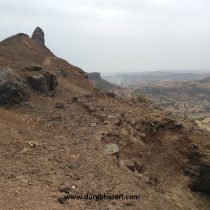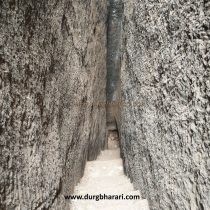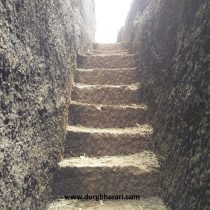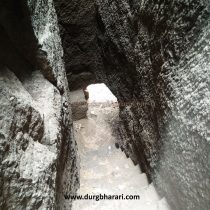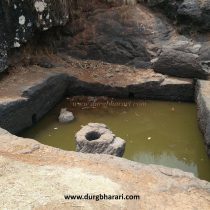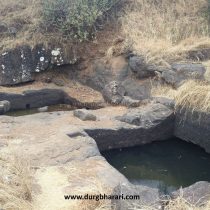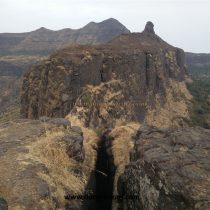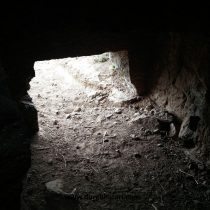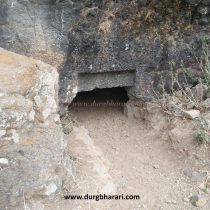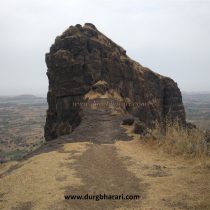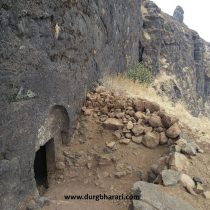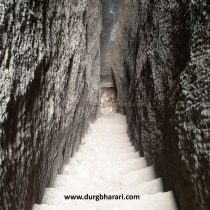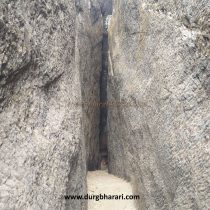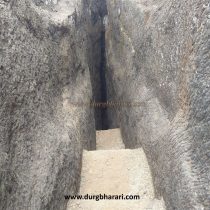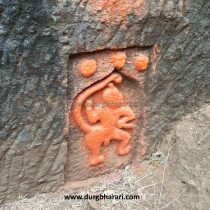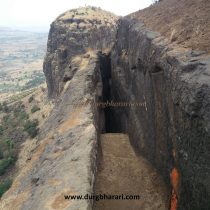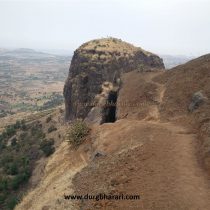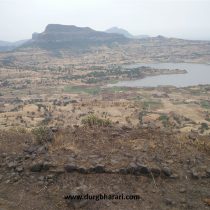DURGBHANDAR
TYPE : HILL FORT
DISTRICT : NASHIK
HEIGHT : 3540 FEET
GRADE : HARD
Trimbakeshwar in Nashik is one of the twelve Jyotirlings in India. The Brahmagiri mountain, one of the twelve Jyotirlings and the source of the river Godavari, is always crowded with devotees. Adjacent to this Brahmagiri mountain, to the south, is the Durgbhandar fort of Brahmagiri. Since the way to Durgbhandar is from Brahmagiri, we have to go to Brahmagiri first. During the Satavahana period, the trade route from Maharashtra to Gujarat passed through the Trimbak mountain range, so the Brahmagiri fort was built for protecting this route. There are many transportation options available to Trimbakeshwar. Although there are two ways to reach the fort, the way up from Trimbakeshwar village is the most convenient. When you reach the foothills of Brahmagiri from Trimbakeshwar temple, your journey to the fort starts from there.
...
After climbing about 500 steps from the bottom on the left side of the road, you can see a dilapidated stone temple. In front of the temple, there are two ruined bastions on the side of the road and some ramparts can be seen next to them. This is the guard's porch on the way to the fort. On the right-hand side, there is a two-storied orphanage in a stone structure and there is a staircase on the outside to go to the upper floor of the orphanage. At the back of this orphanage, there is a well with 70-80 feet deep steps made of stone and on its edge, there is a worn-out inscription. From here, there are stone steps built at the beginning on the next path. The steps are one and a half feet high and are supported by iron bars. Fifteen minutes of climbing from here lead to a guard's cave carved in the rock. The idol of Brahma is present in this cave. There are a large number of monkeys on this road and it is a challenge for tourists to eat. From here, on the next turn, there are a ten feet high idol of Hanuman carved in the rock and there is another cave on the way. A small door is carved on the side of the steps to enter the cave and idols of two sages are carved on either side of the door. After some distance from here, the first gate of the fort comes in front. There are two carvings on the right side of the door of recent times. After going up a few steps through this gate, another stone carved door of the fort comes in front. After climbing a few steps through this door, we reach the top of the Brahmagiri fort. It takes an hour to reach here from the foothills of the fort. From here the front path leads to the hill in the middle of the fort. After walking for a while, take the path on the right towards Jatashankar Temple. At the back of the temple is a water cistern carved in the rock. From here a small footpath leads to the fort at the northern end. Very few people know this unique fort sculpture carved in the rock. On this road, there is a water cistern carved in the rock and the remnants of the outpost can be seen on the bank of the river and at the bastion on the end. At the bottom of the fort, there is a narrow road connecting Bhandardurg and Brahmagiri. At the very end of Trimbakgad, there is a beautiful footpath carved in the rock to reach the fort, but it is not visible until you get very close. There is a 6 to 8 feet wide trench more than 100 feet deep in the rock and about 55 steps of one and a half feet height are carved to descend into it. An idol of Hanuman is carved at the beginning of the steps. Going down these steps, you see a small door. This door is partially buried in the soil, so you have to crawl your way out. After crossing this gate, we exit the Brahmagiri fort and reach the narrow road which connects to the other fort. The passage is a natural wall of about 350 feet long and about 8 to 10 feet wide, with a straight edge of 500 feet on either side of the wall. You have to be careful while crossing this path. After crossing this path, there is another small door like the one you crossed earlier. This gate of the fort is also partially buried in the soil, so it has to be crossed by crawling. Once inside, the path starts climbing once again. By climbing these steps we reach the top of the fort. The fort is located at an altitude of 3980 feet above sea level and is spread over an area of 5 acres from south to north. The fort is standing in front of the trunk of Brahmagiri. When you start walking along the footpath at the top, you first see two water cisterns carved in the rock. One of these tanks has potable water. In five minutes from the cistern, we reach the entire rock-cut bastion at the end of the fort. From the bastion, Harihar (Harshgad) and Basgad can be seen in front, while Brahmagiri, Gangadwar, and Nivruttinath's mausoleum can be seen in the lower right corner. On the way back from here, when you go to the hill on the right side, you can see the quadrangle structures of two houses. From here you can see Anjaneri, Harihar, Basgad, Tringalwadi. Due to the small size of the fort, there are not many remains, the entire fort could be explored in half an hour. The fort must have been designed for the protection of Trimbakgad with its architecture and unique geographical structure. After climbing the steps of Brahmagiri from Durgabhandar, you can go to the path of Brahmagiri on the left side of the bridge without going back. To experience this adventure, one has to explore Brahmagiri-Durgbhandar at least once. As Durgbhandar is a fort or sub-fort of Brahmagiri fort, there are no separate references to it. The reference to the Brahmagiri fort is the same as the reference to the Durgbhandar fort. Considering the style of construction of the Bramhagiri fort, this fort may have been built during the Satvahana period but the history of the fort is known from the Yadav period. During 1271-1308, this area was ruled by King Ramdevrai Yadav. In the thirteenth century, when Vitthalpant, the father of Saint Dnyaneshwar, came with his children to visit Trimbakeshwar, it is said that Nivruttinath saw Gahininath performing asceticism in a cave on the Brahmagiri mountain. Later, the fort came under the rule of the Bahmani dynasty. Malik Ahmed, who established the Nizamshahi after the fall of the Bahmani Empire in 1485, captured the fort in 1487. In 1629, Shahaji Raje conquered this fort and its environs. Shahjahan sent eight thousand cavalries to retake the area. In 1633, the fort of Trimbakgad went to the Mughals. On June 17, 1636, the Mughals and the Adilshahis came together and conquered the Nizamshahi and imprisoned Nizamshah. In 1636, Shahaji Raje was defeated at Mahuli and Trimbakgad was handed over to Khanjaman, the Mughal general. In 1670, the Marathas under the leadership of Moropant Pingale conquered Trimbakgad. Around 1682, the Mughal army of Muzaffar Khan, son of Khanjaman, burnt down three mansions at the foot of the fort. In February 1683, Radho's Khopda shifted to Mughal Sardar Anamat Khan. In November 1684, Akram Khan and Mahmat Khan set fire to the foothills of Trimbakgad and stole the animals. From 1682 to 1684, all attempts to conquer the Mughal fort failed. In August 1688, the fort was besieged by the Mughal Sardar Matbarkhan. In a letter to Aurangzeb, he said, "I have set up check posts around the fort of Trimbak and the fort has been besieged for six months. So the people in the fort will be deported and will surrender. On this, Aurangzeb, in his letter of encouragement to him, says that it will be your job to make every effort to capture the fort of Trimbak. On this Matbarkhan informs Aurangzeb in a letter how he captured the fort. Apart from this, Matabarkhan reports that Harisingh, the son of Shyam Singh, the fort chief of Aundha, has done a great job in this campaign and has given him three hundred cavalries and one thousand infantry to take charge of Trimbakgad. As a reward, jahagir were given while capturing the fort of Salher, the reward and jahagir were given to Telangarao and Shyamraj, the fort keepers of Trimbak. In the decree sent on this, Aurangzeb writes that your application has been received. I got to know that we had conquered Trimbakgad and laid siege to Tringalwadi fort. I have received the Trimbak keys you sent and I like your tactic for conquering the fort. An increase of five hundred rupees has been made in your salary and you are being thirty thousand rupees. Later, around 1691, Mukarrabkhan Badshah, an official from here, writes that the fort keeper of Trimbak died and his son is in debt. He is being harassed by a moneylender and cannot handle Trimbakgad. Someone should send a noble and experienced man as the fort keeper otherwise crisis will fall on the fort. In 1716, Shahu Maharaj demanded this fort from the Mughals but it was rejected. In 1730, the Koli community revolted and took over the fort and it remained under the control of the Peshwas till 1818. After that fort come under the control of the British emperor.
© Suresh Nimbalkar

